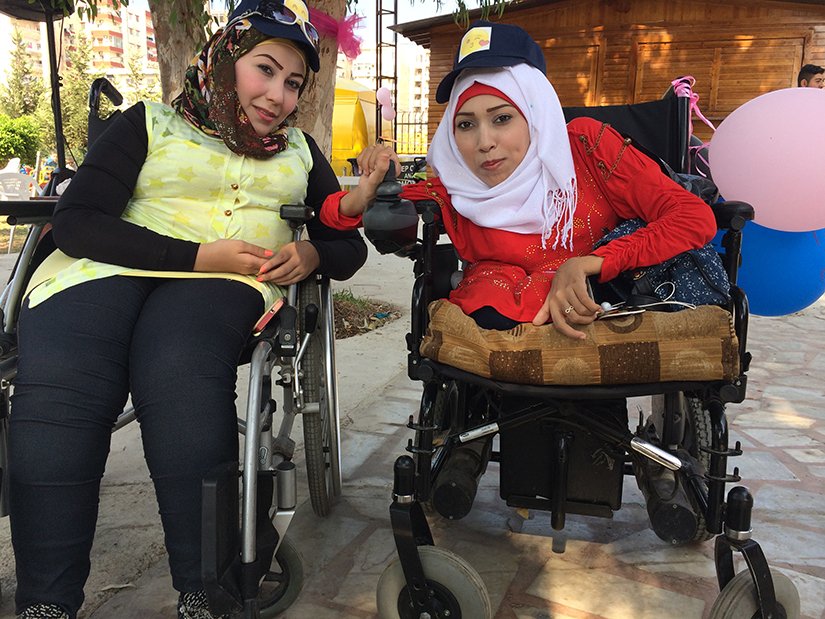This blog is cross-posted from Medium.
As the organization I work for, the Women’s Refugee Commission (WRC), attends Women Deliver this week in Vancouver, Canada, I am excited to see so many people–famous or otherwise–show up for gender equality in what promises to be one of the “biggest-ever global conversations about the health, rights, and well-being of girls and women.”
With women and girls with disabilities making up at least 20% of the population in developing countries and more than half of over 10 million persons with disabilities who have been forcibly displaced, we think it is critical they are part of this wider conversation.

Two adolescent girls participating in Danish Refugee Council’s adolescent girls program in North Lebanon. © Boram Lee/WRC
Just to take a step back: The humanitarian system—the sector I work in—is changing. Grand Bargain commitments that came out of the World Humanitarian Summit in 2016 included an agreement by the largest humanitarian donors and aid organizations to ensure national and local partners are involved in decision-making processes in any humanitarian response, and deliver assistance in accordance with humanitarian principles. At the same time, humanitarian stakeholders made global commitments on disability inclusion, recognizing that persons with disabilities and women and girls are particularly impacted by the effects of humanitarian crises. This led to the Inter-Agency Standing Committee (IASC), the primary mechanism for inter-agency coordination on humanitarian action, to establish a Task Team to develop globally endorsed guidelines on inclusion of persons with disabilities.
As a member of the Task Team supporting this process, WRC is contributing our own expertise on gender and gender-based violence (GBV) and engaging with local organizations of persons with disabilities and women-led organizations in particular to ensure that the Guidelines are fit for purpose and adaptable to all kinds of humanitarian contexts worldwide. As part of this work, we partnered with GBV actors on the ground in Jordan, Sri Lanka, and Uganda, including organizations of women with disabilities, to test the IASC Guidelines, provide feedback, and document outcomes.
Here is what we learned about what works:
- Participation. Consult with diverse groups of girls, boys, women, and men with different disabilities, understanding that persons with disabilities are not homogenous. Their needs, protection risks, and capacities can vary by sex, age, types of impairments, as well as other intersecting factors such as sexual orientation, gender identity, expression, or sex characteristics (SOGIESC), religion, ethnicity, and other identities. Ask them about barriers and appropriate strategies to make GBV activities and services accessible to them and adapt programming accordingly, including by monitoring their access. This ensures that humanitarian programmers are responsive and accountable to the populations they are meant to serve. Moreover, training women and girls with disabilities on GBV and their rights not only improved their knowledge and awareness of how to access services, but also increased their interest in sharing information with others and contributing to the wider empowerment of women and girls in the community. “When I got trained on GBV, I got the power to support my fellow women with disabilities. I need to be trained as a paralegal so that the community can recognize me,” Woman with disability, Bidibi settlement in Uganda.
- Partner with local organizations of persons with disabilities and especially those that are women-led. In all pilot contexts, partners reported strengthened coordination and referrals between different GBV service providers, which ultimately improves access for women and girls with disabilities in need of GBV services.
- Ensure protection is mainstreamed, including prevention of sexual exploitation and abuse (PSEA) standards in accordance with humanitarian principles. With any work with marginalized communities and because of power imbalances, the potential for abuse and risks of causing harm always exists. Every humanitarian actor, including local organizations, have an ethical responsibility to identify and mitigate any potential risks as a normal part of programming.
As a research and advocacy organization, advocating for over a decade to advance the rights of displaced women and girls with disabilities globally, we are excited and emboldened to see these high-level, global commitments to affected communities come to fruition. As we look ahead to the next 10 years of disability rights work, I like to think that as humanitarians, we are iterative and reflective. We internalize lessons learned, are honest about our failures, and ask ourselves, “What does it all mean in the lives of women and girls who have been impacted by conflict or crisis?”

